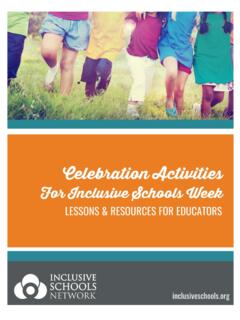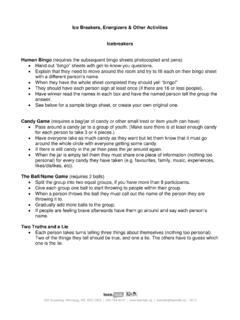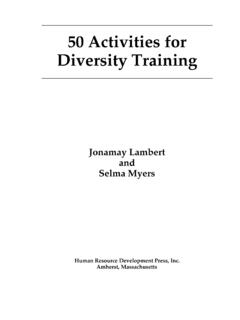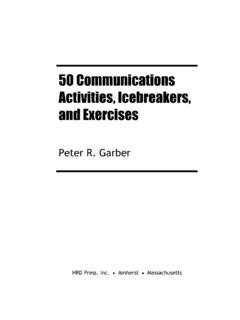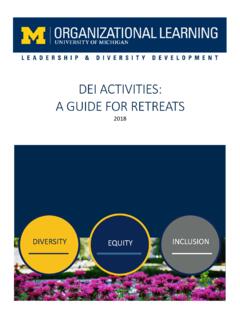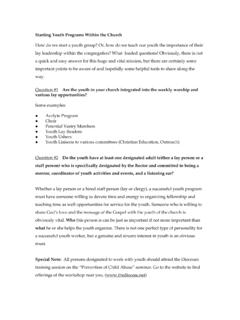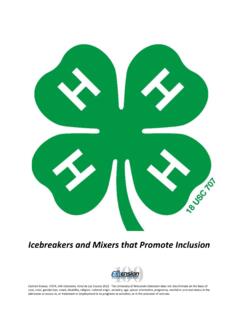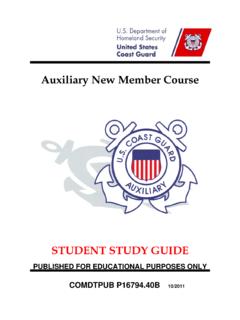Transcription of Student Connection Activities and Icebreakers
1 Julie A. Pack A Collection of Icebreakers and Connection Activities G E T T I N G S T A R T E D 1 Icebreakers and Connection Activities Julie Pack Asheboro High School 1221 S. Park Street Asheboro, NC 27203 Phone G E T T I N G S T A R T E D 2 Using Icebreakers and Connection Activities The How-To s of leading connecting Activities . or a group to function well, its members must be comfortable as well as familiar with each other. The effectiveness of the group will be directly affected by the ability of the group to work together. Using Icebreakers promotes just what the name implies: they break the ice that forms when unfamiliar people meet together. When used in a supportive situation, Icebreakers help to create an atmosphere that reduces the participants inhibitions and increases their awareness of each other. Group facilitators need to be aware that Icebreakers must be highly structured and ensure that time is used productively.
2 To reduce the risks and maximize the benefits for participants, group facilitators should be mindful of the following guidelines. Voluntary Participation Forcing group members to participate in an activity could severely reduce the effectiveness of the activity. The group facilitator should encourage all group members to participate, but make it clear to group members that any participant has the right to refrain from engaging in any activity that appears too uncomfortable or awkward. It s about having fun The group facilitator s job is to make participants feel comfortable or at ease. Enjoy the group facilitator role and allow the participants to see you engaging in and enjoying the process. Try not to discount anyone s concerns or inhibitions about an activity. Whatever a participant decides, it is his or her choice. Make it clear to the participants that you respect their choice. Chapter 1 F G E T T I N G S T A R T E D 3 Confidentiality Unless otherwise agreed, the information generated during an activity should be considered confidential, particularly Activities that are labeled moderate and high risk exercises.
3 As the group facilitator, you must go over the ground rules prior to engaging in any activity where information may be generated that is personal. Addressing the ground rules and having everyone agree will help to ease participants discomfort and uneasiness about sharing with unfamiliar people. Have everyone in the group agree to the confidentiality rule prior to beginning the activity. When processing or debriefing Activities , remind participants of their agreement to the confidentiality rule. Group Facilitator as Model Participants will be more inclined to participate in any activity where the facilitator is an active participant and appears to be enjoying the activity. You will find that even your reluctant participants will be more willing to take modest risks when you participate in the activity. Never ask a group to do any activity that you are unwilling to demonstrate or participate in. It is often helpful if the group facilitator will demonstrate fully what is expected of the group for the group to see after giving instructions and prior to asking the group to begin the activity.
4 Participants will have an opportunity to ask questions and match their understanding of the directions to the facilitator s expectations. Process or Debrief Activities After every activity, the group facilitator should take time to debrief or process the activity with the participants. The processing is more important as the risk level of the activity increases. Although Icebreakers are a low-risk activity, the group facilitator should still monitor the issues and concerns raised during an activity as well as the group dynamics. Set Ground Rules Ground rules build trust and allow participants to feel more comfortable with an activity. The end activity is just as important as the activity debrief with the group. G E T T I N G S T A R T E D 4 Questions and debriefing information can be found in more depth in the activity debriefing chapter of this manual. Do not skip this important step in the activity. Often much of the Connection between group members occurs when Activities are debriefed with the group.
5 Consider Carefully When you plan Connection Activities , consider carefully the appropriateness of the activity. Things to consider when selecting the correct activity include: 1. Determine the growth level of the group. Risk levels should match accordingly. For example, a new group or newly reacquainting group should start with low-risk Activities . As group dynamics mature and grow, the risk level can increase accordingly. 2. The premature use of a higher risk activity or overuse of low-risk Activities could leave participants feeling that the structure is too manipulative. Keep in Mind Keep in mind that an icebreaker or Connection activity is simply a learning tool for a group. The process is much more important than the product. Following these general guidelines will help you as the group facilitator to improve the group interaction and create an atmosphere of trust where Connection can take O W R I S K A CT I V I T I E S ~ I C E B R E A K E R S 4 L O W R I S K A CT I V I T I E S ~ I C E B R E A K E R S 5 Low Risk Activities ~ Icebreakers Perfect for introducing strangers and getting people involved and moving.
6 He variety and versatility of Icebreakers makes it easy to customize Activities to fit any situation. The group facilitator should choose appropriate Activities that will bring groups together by reducing inhibitions through stimulating, challenging, and motivating the participants. These Activities are perfect for warming up a group, beginning a program, starting a new session, ready the learners for new content material, or shifting the focus of study. Have fun with these Activities and add your own as you become more comfortable with the process. Remember to prepare several debriefing questions to ask following the activity. Name Games The purpose of these Activities is for participants to learn each other s names. These Activities are most effective in the early stages of group development and can be modified numerous ways to be fun and be creative. Pass the Bear The group size can be small or large, but works best with no more than 30 people.
7 Arrange the room where everyone is either standing or sitting in a circle. The group facilitator will need a prop of some sort, usually a stuffed animal works best. Explain to the group members that they will receive a stuffed bear [or whatever object you use] from the person sitting next to them. The facilitator starts by saying, My name is _____, and I have the bear. I m going to give it to _____ Chapter 2 T L O W R I S K A CT I V I T I E S ~ I C E B R E A K E R S 6 (and say the person s name sitting next to the facilitator.) The next group member says, My name is _____, and I have the bear which came from _____ (facilitator s name). I m going to give it to _____ [the person sitting next to group member] The process continues as each group member in turn states his name and the names of ALL group members who had the bear before him/her. Once the object returns to the facilitator, s/he repeats the names of each group member in proper order.
8 DON T the time the entire group has repeated all the names of the group over and over, you will be able to have learned them all. In addition, if you stumble, it s okay. Remember, it s about the process not the product. Zoo Names The group size can be small or large, but works best with no more than 30 people. Arrange the room where everyone is either standing or sitting in a circle. No props are needed for this activity. Tell each group member to come up with an animal that starts with the same letter as their first name. The facilitator should demonstrate with his or her own name. For example: Jaguar Julie If the facilitator will be known to the group as Mr. or Ms. Last Name, explain to the participants the reasoning and proceed with an example for facilitator s last name. For example, This year you will be calling me Ms. Pack, so I will use that name. However, since the rest of you will be called by your first names, think of something that goes with that.
9 So I m Penguin Pack. The next person introduces the previous person(s). This is Penguin Pack and I m Jaguar Julie. Continue around the circle allowing every participant to start from the facilitator and then add themselves to the end of the list until finally reaching the facilitator again. The facilitator should then repeat all the animal/names of the participants in order. L O W R I S K A CT I V I T I E S ~ I C E B R E A K E R S 7 Thank You The group size can be small or large, but works best with no more than 30 people. Arrange the room where everyone is either standing or sitting in a circle. The facilitator will need a few stuffed animals to use during the activity. Explain to the group that they will be passing a stuffed animal to someone in the group (they can choose anyone who has not already been chosen.) The facilitator should demonstrate what should be said before the toss is made.
10 Here it comes, John. John should catch the animal and say Thank you, Julie. John should then take the animal and say, Here it comes, Ann. Ann should catch the animal and say, Thank you, John. The facilitator should explain that the participants need to remember only two people s names, the one who threw it to them and the one to whom they are throwing. The process continues until the animal has been tossed to everyone and returns to the facilitator. Options: Time the initial round and see if participants can reduce the amount of time it took to redo the exercise in exactly the same order. Once the animal has started around the circle, the facilitator can unexpectedly send a second or third animal to continue in the same order. Let s go on a picnic The group size can be small or large, but works best with no more than 30 people. Arrange the room where everyone is either standing or sitting in a circle.
